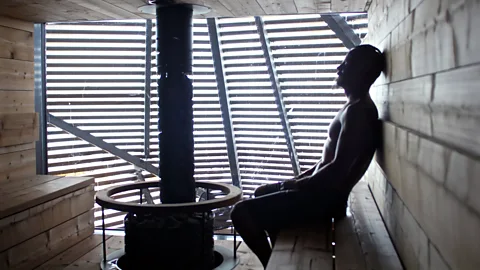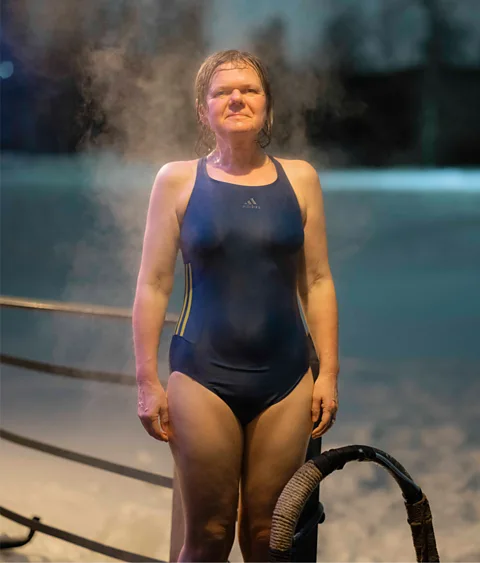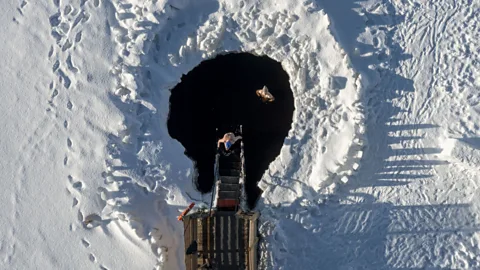Finland is obsessed with saunas, but are they any good for you?
 Getty Images
Getty ImagesThe Finnish tradition of a sauna followed by a plunge into icy water or a roll in the snow is spreading around the world. What does science say about the claimed health benefits?
Sometimes I wonder why I do these things to my body. I'd just been for a mid-winter run in a frozen park in the Finnish city of Oulu. The air temperature was -15C (5F). At 170km (106m) south of the Arctic Circle, this is the world's northernmost Parkrun.
Less than an hour later, I ducked into a sauna – a dimly-lit wooden room where intense heat was radiating from a massive wood-burning stove. The thermometer read 85C (185F).
As I sat there, sweating like crazy, a fellow sauna-goer threw a ladleful of water onto the stove's hot stones to make "löyly" – Finnish for a sudden burst of steam that surges through the air. It's a powerful sensation, almost shocking. The heat reached deep into my skin and muscles, melting away any tension.
But that wasn't enough for me. Stepping outside into the cold air, steam rose from my body, and I clambered down an ice-encrusted ladder into the excruciatingly cold water of the Oulu River, which had a temperature of around 1C (34F). I felt piercing pain, like a million needles striking my skin.
But I didn't jump out. Instead, I counted slowly up to 12. And after a few seconds the pain seemd to disappear – I actually felt okay with it. It was almost like an icy hug. When I clambered out, the air around me seemed almost warm.
To some, it might sound like the morning schedule of a deranged masochist. But this sequence of cold, hot and then cold again made me feel strangely alive. A sauna followed by an ice bath is known as contrast therapy in sports medicine – and it feels surprisingly good. When I do it, I experience a rush of energy, which gives way to a mood of happiness.
It's something I have long enjoyed, like millions of other Finns who regularly take part in the traditional sauna bathing rituals. It is such an important part of life in Scandinavia that Sweden's entry to this year's Eurovision Song Contest – performed by Kaj, whose members hail from Finland – is an ode to the sweaty heat of saunas. The song "Bara Bada Bastu", which translates roughly as "just take a sauna", had been among the favourites in the competition and had been topping the charts ahead of the competition. In the end the performance came in fourth place.
To those outside of Finland the lurch from cold, to hot and to cold again can seem extreme, but it is a health craze that is now spreading beyond Scandinavian borders to other parts of the world.
So I wanted to delve into the science behind the Finnish sauna and find out whether it really is good for me.
 Antti Leinonen
Antti Leinonen"Finns go to the sauna at least once a week and spend between five to 30 minutes in about 80-100C (176-212F) heat," says Heikki Junkkari, a doctor who sits on the board of the Finnish Sauna Society, an organisation that has promoted Finnish sauna culture since 1937.
Saunas have existed for thousands of years and going to them is a deeply-rooted part of Finnish life. It unites Finns across generations and regions. Saunas have even made it onto Unesco's Intangible Heritage List.
There are an estimated 3.3 million saunas in this country of 5.5 million people, meaning they are accessible to almost everyone. Sauna users often cool off in an icy lake or river or take a cold shower. People typically alternate between hot and cold several times, says Junkkari.
But going from heat to ice is an intense experience that affects blood circulation in the human body, says Setor Kunutsor, a cardiovascular epidemiologist at the University of Manitoba.
"When you go to the sauna, the temperature inside the body goes up slowly from 37C (99F) to as high as 39C (102F). Blood vessels dilate, you start sweating and that reduces blood pressure," he says. "Being immersed in cold water does the opposite: blood vessels contract and blood pressure goes up."
Many medical papers have discussed the potential health benefits and risks of saunas and cold baths, but Junkkari warns that many of these studies lack scientific quality.
"Very few studies are good quality randomised controlled trials," he says, referring to a scientific methodology in which participants in a study are randomly sorted into groups in order to test the effectiveness of a drug, activity or some other intervention.
There are also reports in the medical literature of people who have fallen ill and even died after diving straight from the heat of a sauna into ice cold water. One 1998 study, for example, reported the case of a person in Japan who died from a heart attack after entering cold water immediately after leaving a sauna. Data suggests, however, that these incidents are extremely rare. Most tend to involve people who have been drinking alcohol or have pre-existing conditions.
There have been some studies, however, that also warn short sauna baths interspersed with rapid cooling is associated with heart arrhythmia in patients with existing cardiovascular disease. A case report published earlier this year also warned how a patient needed hospital care in Birmingham, UK, for 12 days after suffering heatstroke in a sauna that led to a heart attack, seizures and injury to the liver and kidneys.
More like this:
• The 10,000-year-old origins of the sauna
• Why some people can deal with the cold
• Estonia's naked wellness tradition to cleanse body and soul
But there is other evidence that suggests sauna bathing may well have a protective effect against sudden cardiac death.
Kunutsor has worked with Finnish cardiologist and reseracher Jari Laukkanen on some of the largest sauna and ice bath studies to date. Their research is based on data collected during a 20-year period, involving 2,682 middle-aged and older men in eastern Finland.
This research, which is part of an ongoing observational study, suggests that there could be positive effects of sauna use on respiratory health, dementia and cardiovascular health.
"Going to the sauna a few times a week is associated with a reduced risk of high blood pressure, heart disease and sudden cardiac death," says Kunutsor. The reason, he and his colleagues suspect, may be linked to the effect sauna bathing and cold immersion has on the cardiovascular system as blood vessels rapidly dilate and contract. This may reduce arterial stiffness, they say, but also help to control other risk factors such as inflammation and stress.
 Getty Images
Getty ImagesThose who combine sauna with exercise may experience even more cardiovascular benefits, adds Kunutsor. He and colleagues set up a randomised controlled trial in which one group of 47 participants used a sauna and did exercise three times a week, for eight weeks, while another group only did the exercise.
"We found that sauna sessions combined with exercise produced a mean reduction of eight millimetres of mercury," says Kunutsor, referring to a measure of blood pressure. "This is a very substantial reduction."
There is also some research that suggests sauna use might also be good for the brain.
In 2017, Kunutsor and his colleagues published a study of more than 2,300 men over a 20-year period. Men who took part in two to three sauna sessions a week had a 20% lower risk of Alzheimer's disease and 22% lower risk of dementia than those who only took one weekly sauna. The effect was enhanced the more frequent the sauna use was, with a 66% reduction in dementia and 65% in Alzheimer's disease among those who used a sauna between four and seven times per week, compared with those who only used the sauna once per week.
"We've found a strong inverse association between the frequency of sauna bathing and the risk of dementia and Alzheimer's disease," says Kunutsor.
The study did not, however, compare the effects of a sauna against the risk in men who did not use saunas at all and so the results may also reflect something more generally about the lifestyles of people who have time to indulge in sauna bathing in the first place. It is also worth remembering such observational results do not necessarily mean a direct cause and effect relationship between saunas and dementia. Instead it provides a glimpse at an effect that warrants further research.
Nonetheless, Kunutsor and Laukkanen's observational research has also found hints that frequent sauna bathing may reduce the risk of mental disorders.
Anecdotal reports of psychological benefits associated with sauna use include that of Juha Mieto, a well-known Finnish cross-country skier. He credits saunas with restoring both his and his son's mental well-being after the sudden death of his wife.
"It was a huge shock. My son had just turned eight. I started heating the sauna at 6pm every evening. It became a ritual that brought us calm," Mieto recalls. "We kept this up for many years. Sauna played a key role helping us find peace, giving rhythm to our lives."
One possible explanation is that people find sitting in a hot, scent-filled room relaxing by triggering short-term changes in certain hormone levels. A randomised controlled study found that regular sauna bathing was effective at reducing the intensity of chronic tension headaches, for example.
"When you go to the sauna, hormones that respond to physiological stress will increase. Levels of endorphins, our body's natural mood-boosters, our internal feel-good chemicals, will go up," says Ilpo Huhtaniemi, an endocrinologist at Imperial College London, who co-authored a review of research on how saunas effect hormones. "There's also an increase in growth hormone levels, although all these hormonal changes tend to be short-term."
Martha Newson, an associate professor of psychology at the University of Greenwich in the UK, is currently conducting a study with the British Sauna Society to assess how the rituals associated with sauna bathing can effect people's mental wellbeing. "Sauna is a space where our norms and conventions are temporarily suspended – we take off our clothes, sit in close proximity, and endure extremes together," she says. "These are great, ritual environments for our identities to transform."
Sauna therapist Laura Foon says the warm, calm atmosphere induces a sense of relaxation. "Today, we're constantly on high alert," she says. "Diving into soothing darkness in the sauna is profoundly healing." It is like returning to the womb, she suggests. The sauna is a reassuringly safe space.
But what about when you skip out of the sauna and plunge yourself into a lake shrouded in ice? That's not exactly womb-like.
When a person enters cold water, they experience an increase in heart rate and blood pressure – a reaction known as "cold shock". Generally, their heart rate and blood pressure return to normal levels shortly after leaving the water.
Somewhat counterintuitively, regular exposure to cold water can lead to a remarkable change in the opposite direction: a decrease in both average heart rate and blood pressure.
Huhtaniemi says there's also a hormonal reaction: the cold triggers a release of neurotransmitters, including norepinephrine, which plays an important role in the body's "fight-or-flight" response. It increases blood pressure and causes heightened alertness, also giving a boost of energy.
"Cold water raises the levels of other hormones such as serotonin, cortisol, dopamine and endorphin that play a role in emotion and stress regulation," Huhtaniemi says.
Ice baths can have various effects on both our bodies and minds, says Antti Lindfors, a cultural researcher at the University of Helsinki, and an ice swimmer who has interviewed other winter swimmers about their experiences.
His main finding, based on 640 responses, is that ice swimmers say the activity makes them feel bolder and more self-confident.
"People view entering a frozen body of water as a mental feat. Once you've done it, everything else becomes less of a struggle," says Lindfors.
 Erika Benke
Erika BenkeStudies suggest that cold amplifies emotions and bodily sensations. Lindfors hypothesises that learning to relax while in cold-induced pain, for example, may help people deal with stress in other areas of their lives.
One Finnish study of 49 people found that winter swimmers reported reduced tiredness, improved mood and self-esteem versus a control group.
"Winter swimming is probably not a miracle treatment for mental health problems but it's worth trying out," says Lindfors. "The key to success is learning to accept the cold rather than shutting down for a few painful seconds and quickly escaping."
Lindfors suggests that the best results occur when people endure temperatures of between 0-10C (32-50F), and over a period of at least 30 seconds for two or three times a week.
That said, swimming in very cold water can be dangerous. Some people have died during cold water swimming sessions, due to risks including cold shock and incapacitation. Medical experts say that it can raise your blood pressure to dangerous levels, especially in people with undiagnosed heart conditions, for example. They also recommend having supervision or help close by when undertaking cold water swimming, in case you get into difficulties.
There is also the risk of hypothermia if people remain immersed in the cold water for too long.
Lindfors cautions that it is important for cold water bathers to acclimatise to the experience by using progressively colder water. "It will take about two weeks for the body to adapt. It's important not to overdo it; stay as long as it feels right," he says.
Huhtaniemi agrees. "Doing it little by little is very important," he says. "Gradual adaptation helps minimise any negative effects."
Lindfors and Huhtaniemi say it is still not clear how years of ice baths may affect the human body – there have been no long-term studies on this.
Knowing there is at least some research supporting the health benefits of saunas and ice baths has added depth to what was previously just a "feels good" ritual for me.
Hopefully my body will be a bit more grateful too.
* All content within this article is provided for general information only and should not be treated as a substitute for the medical advice of health care professionals.
--
For trusted insights into better health and wellbeing rooted in science, sign up to the Health Fix newsletter, while The Essential List delivers a handpicked selection of features and insights.
